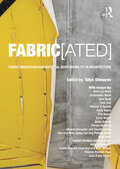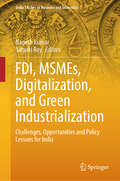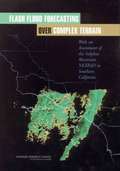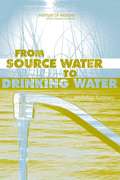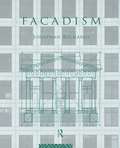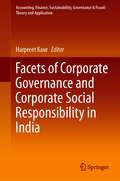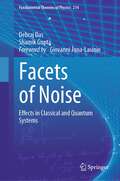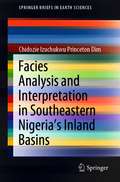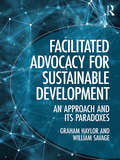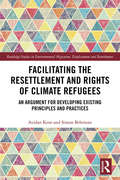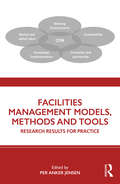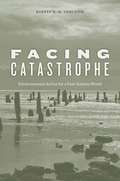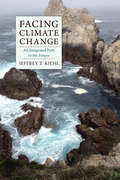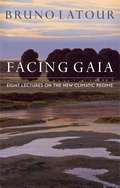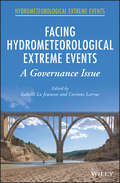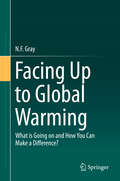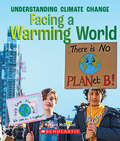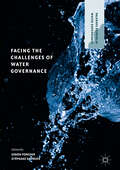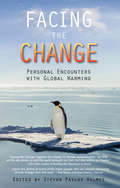- Table View
- List View
FABRIC[ated]: Fabric Innovation and Material Responsibility in Architecture
by Tolya StonorovFABRIC[ated] examines fabric as a catalyst for innovation, reflection, change and transformation in architecture. This book explores the ways in which research and development of fabric can, and historically has, influenced and revolutionized architecture, teaching and design. Responsive, flexible, impermanent, fluid and adaptive—fabric interacts with, and influences architecture, offering innovative solutions and increased material responsibility. Foundation and theory chapters establish clear precedent and futures for fabric’s position in architectural discourse. The case study section examines 14 international projects through three different threads: Veiling, Compression and Tension. Case studies include a diverse range of projects from the HiLo unit at Nest and CAST’s fabric formed concrete projects to a discussion of the impact of fabric on SO-IL and Kennedy Violich Architect’s professional work, demonstrating new and fresh methods for addressing sustainability and social justice through the use of fabric in architecture. Through the work of the many authors of this book, we see fabric as drape, skin, veil, mold, concept and inspiration. Fabric, in its broadest definition, is an important and innovative material in the development of socially conscious architecture. Offering readers pedagogical and practical models for international projects highlighting fabric’s use in architecture, this book will appeal to the novice and the expert, architecture students and practitioners alike.
FDI, MSMEs, Digitalization, and Green Industrialization: Challenges, Opportunities and Policy Lessons for India (India Studies in Business and Economics)
by Nagesh Kumar Satyaki RoyThis book presents fresh research on how Foreign Direct Investments (FDI), Micro, Small and Medium Enterprises (MSMEs), patterns of clustering, digitalization and innovation policies, interact and influence India’s industrialisation and its greening or sustainability. As India seeks to accelerate its process of industrialization especially focusing on the manufacturing sector, different interactions between agents of industrialization need to be understood better through evidence-based research. The volume through its 17 original contributions, focuses on three broad interrelated themes: FDI, export performance, innovation and environmental sustainability; growth, competitiveness and spatial distribution of MSMEs concerning access to finance, digitalisation and sustainability; and, green technology, circular economy and challenges towards clean transition and green industrialization. Research presented in this book does not see industrialization as an isolated process from globalization and appreciates the need to act upon specific impacts of foreign trade and investments. With a focused and futuristic approach towards industrialisation in India, it provides rigorous evidence-based treatment of complex interactions using secondary and primary sources of data deploying appropriate analytical techniques. In light of empirical findings, each chapter comes up with policy lessons for industrial strategy. Shedding new light and evidence, this book makes an important contribution by helping to generate a better understanding of the process of green industrialization and how it can be fostered to create inclusive and sustainable prosperity. It will be an invaluable resource for policymakers, analysts, researchers and students of industrial and environmental economics.
FDTD Analysis of Plasmonic Devices (Springer Series in Optical Sciences #254)
by Jun ShibayamaThis book offers a comprehensive exploration of the Finite-Difference Time-Domain (FDTD) analysis of plasmonic devices, shedding light on their applications from optical to terahertz regimes. By delving into frequency-dependent formulations and innovative computational methods, it provides a robust framework for understanding the intricacies of plasmonic devices. Key concepts such as surface plasmon polariton, surface plasmon resonance, and metal-insulator-metal waveguides are meticulously examined. The book addresses critical questions about the efficiency and functionality of plasmonic sensors and demultiplexers, offering insights into the latest advancements in the field. With contributions from leading experts, it presents a blend of theoretical perspectives and practical case studies, making it an essential resource for anyone interested in cutting-edge plasmonic technology. Engineers, researchers, and graduate students in the fields of optics and terahertz technology will find this book invaluable. It not only can enhance their understanding of FDTD methods but also will equip them with the knowledge to apply these techniques to real-world plasmonic device applications. Whether for a seasoned professional or a curious learner, this book is a gateway to the future of plasmonic research.
FLASH FLOOD FORECASTING OVER COMPLEX TERRAIN: With an Assessment of the Sulphur Mountain NEXRAD in Southern California
by National Research Council of the National AcademiesThe nation's network of more than 130 Next Generation Radars (NEXRADs) is used to detect wind and precipitation to help National Weather Service forecasters monitor and predict flash floods and other storms. This book assesses the performance of the Sulphur Mountain NEXRAD in Southern California, which has been scrutinized for its ability to detect precipitation in the atmosphere below 6000 feet. The book finds that the Sulphur Mountain NEXRAD provides crucial coverage of the lower atmosphere and is appropriately situated to assist the Los Angeles-Oxnard National Weather Service Forecast Office in successfully forecasting and warning of flash floods. The book concludes that, in general, NEXRAD technology is effective in mountainous terrain but can be improved.
FROM SOURCE WATER TO DRINKING WATER: Workshop Summary
by Medicine Research Roundtable on Environmental Health SciencesInformation on the movement from source water to drinking water
Fabrication and Properties of High-Performance 122-Type Iron-Based Superconducting Wires and Tapes (Springer Theses)
by Chao YaoThis book addresses new ways to optimize the fabrication process and performance of iron-based superconducting wires and tapes based on the powder-in-tube (PIT) method. Further, it systemically analyzes and enhances the current-carrying ability of wire and tape conductors with regard to chemical addition, mechanical deformation, and heat treatment. The microstructure of the superconducting cores is studied by means of the magneto-optical imaging technique, high-resolution transmission electron microscopy, and flux pinning analysis. This book will benefits all students, researchers, and technical personnel who work in superconducting materials, applied superconductivity, and the power industry.
Facadism
by Jonathan RichardsFacadism - the preservation of historic facades, the creation of facsimiles in front of new buildings and the decorative exercises of postmodernism - is accused of destroying architectural innovation, of divorcing the interior and exterior of buildings and of reducing townscapes to theatre sets. Its defenders describe facadism as the way urban tradition and progress walk hand in hand. Facadism presents a critical analysis of a concept central to the way in which the city is being remodelled. Assessing architectural and townscape philosophies and their aesthetics, the principles of urban conservation, the process of heritage planning and the market forces of urban development, the book builds a complete picture of the causes and effects of facadism in the Twentieth Century.
Facets of Corporate Governance and Corporate Social Responsibility in India (Accounting, Finance, Sustainability, Governance & Fraud: Theory and Application)
by Harpreet KaurThis book focuses on the legal and social aspects of corporate governance through doctrinal and empirical research papers presented at the 9th International Conference on Governance Fraud Ethics and Social Responsibility held at National Law University Delhi in 2018. The papers encompass the internal and external factors that affect the interests of a company’s stakeholders, including shareholders, customers, suppliers, government regulators and management, and several other important players. The book provides better clarity on the concept of corporate governance and how it is intertwined with factors such as sustainability, social responsibility and the role of government, taxation and audit, and shareholder engagement.
Facets of Noise: Effects in Classical and Quantum Systems (Fundamental Theories of Physics #214)
by Shamik Gupta Debraj DasThis book provides a captivating journey through the realms of classical and quantum systems as it unravels the profound influence that noise may have on their static and dynamic properties. The first part of the book offers succinct yet enlightening discussions on foundational topics related to noise. The second part focuses on a variety of applications, where a diverse spectrum of noise effects in physical systems comes to life, meticulously presented and thoughtfully analyzed. Whether you are a curious student or a dedicated researcher, this book is your key to gaining invaluable insights into noise effects in physical systems. “The book has the merit of presenting several topics scattered in the literature and could become a very useful reference.” Giovanni Jona-Lasinio, Sapienza – Università di Roma, Italy
Facies Analysis and Interpretation in Southeastern Nigeria's Inland Basins (SpringerBriefs in Earth Sciences)
by Chidozie Izuchukwu DimThis book broadens the reader's knowledge base on lithofacies distribution, facies succession and association, and interpretation of paleo-depositional environments using outcrop-based and measured se¬dimentologic section data integrated with facies and petrographic analyses. Besides, the author also provides step-by¬step workflow that could guide detailed geological field mapping and improve outcrop studies across Middle-Upper Cretaceous (Cenomanian–Campanian) successions of Southern Benue Trough and the lower stratigraphic interval of Anambra Basin, outcropping in Afikpo area of Southeastern Nigeria.
Facies Models 4
by Noel P. James Robert Walker DalrympleThe Geological Association of Canada's Facies Models 4 is the essential volume on sedimentary succession interpretation. Presented in full color, this updated edition of the original, highly popular textbook Facies Models incorporates the enormous advances in our understanding of depositional environments since the last edition was issued in 1992. Coverage of this topic is at the advanced undergraduate- to graduate-student level, making this book accessible to anyone with an interest in sedimentary environments.
Facilitated Advocacy for Sustainable Development: An Approach and Its Paradoxes
by Graham Haylor William SavageFacilitated advocacy is an approach to development initiatives that enables people situated across diverse cultural, economic, educational, professional, societal and linguistic spheres to engage more equitably. By doing so, potential changes in policy and practice can improve people’s livelihoods and life circumstances. This book provides context and definition for facilitated advocacy. It suggests a role for the approach, as the world once again embarks on a set of UN-coordinated development goals. The book outlines the skills and experience required to facilitate groups of people in order to identify and advocate for changes that they consider necessary. This is illustrated through a series of co-authored case studies from Cambodia, Ghana, India, Kenya, Pakistan, Sri Lanka and Vietnam. These range from standing up for the rights of tribal communities in eastern India and improving service delivery to villages in Vietnam, to developing an inclusive fisheries policy in Pakistan and building social enterprises in Odisha State of India. This book offers a critically reflective description of what has been tried, adapted and replicated, furthering action research in the field of development studies. It offers theorists and practitioners an opportunity to examine their own work in contrast and in recognition of the realities of living with paradoxes.
Facilitating the Resettlement and Rights of Climate Refugees: An Argument for Developing Existing Principles and Practices (Routledge Studies in Environmental Migration, Displacement and Resettlement)
by Avidan Kent Simon BehrmanOne of the most significant impacts of climate change is migration. Yet, to date, climate-induced migrants are falling within what has been defined by some as a ‘protection gap’. This book addresses this issue, first by identifying precisely where the gap exists, by reviewing the relevant legal tools that are available for those who are currently, and who will in the future be displaced because of climate change. The authors then address the relevant actors; the identity of those deserving protection (displaced individuals), as well as other bearers of rights (migration-hosting states) and obligations (polluting states). The authors also address head-on the contentious topic of definitions, concluding with the provocative assertion that the term ‘climate refugees’ is indeed correct and should be relied upon. The second part of the book looks to the future by advocating specific legal and institutional pathways. Notably, the authors support the use of international environmental law as the most adequate and suitable regime for the regulation of climate refugees. With respect to the role of institutions, the authors propose a model of ‘cross-governance’, through which a more inclusive and multi-faceted protection regime could be achieved. Addressing the regulation of climate refugees through a unique collaboration between a refugee lawyer and an environmental lawyer, this book will be of great interest to scholars and professionals in fields including international law, environmental studies, refugee studies and international relations.
Facilities Management Models, Methods and Tools: Research Results for Practice
by Per JensenThis book presents research tested models, methods and tools that can make the work of the facilities manager more robust and sustainable, help long-term strategic planning and support students and practitioners in FM to improve the way they approach and deal with challenges in practice. The 34 models, methods and tools are presented in relation to five typical challenges for facilities managers: Strategy development Organisational design Space planning Building projects Optimisation The chapters are short and concise, presenting a central illustration of one model, method or tool with explanatory text and short, exemplary case studies. Each chapter includes references to further reading, and the book includes a keyword index. Essential reading for all involved in the management of built assets, this book bridges the gap between robust academic research and practical industry tools. It can also be used as a handy student reference.
Facing Catastrophe: Environmental Action for a Post-Katrina World
by Robert R. VerchickAs Hurricane Katrina vividly revealed, disaster policy in the United States is broken and needs reform. What can we learn from past disasters—storms, floods, earthquakes, tsunamis, landslides, and wildfires—about preparing for and responding to future catastrophes? How can these lessons be applied in a future threatened by climate change? In this bold contribution to environmental law, Robert Verchick argues for a new perspective on disaster law that is based on the principles of environmental protection. His prescription boils down to three simple commands: Go Green, Be Fair, and Keep Safe. “Going green” means minimizing exposure to hazards by preserving natural buffers and integrating those buffers into artificial systems like levees or seawalls. “Being fair” means looking after public health, safety, and the environment without increasing personal and social vulnerabilities. “Keeping safe” means a more cautionary approach when confronting disaster risks. Verchick argues that government must assume a stronger regulatory role in managing natural infrastructure, distributional fairness, and public risk. He proposes changes to the federal statutes governing environmental impact assessments, wetlands development, air emissions, and flood control, among others. Making a strong case for more transparent governmental decision-making, Verchick offers a new vision of disaster law for the next generation.
Facing Climate Change: An Integrated Path to the Future
by Jeffrey KiehlFacing Climate Change explains why people refuse to accept evidence of a warming planet and shows how to move past partisanship to reach a consensus for action. A climate scientist and licensed Jungian analyst, Jeffrey T. Kiehl examines the psychological phenomena that twist our relationship to the natural world and their role in shaping the cultural beliefs that distance us further from nature. He also accounts for the emotions triggered by the lived experience of climate change and the feelings of fear and loss they inspire, which lead us to deny the reality of our warming planet.But it is not too late. By evaluating our way of being, Kiehl unleashes a potential human emotional understanding that can reform our behavior and help protect the Earth. Kiehl dives deep into the human brain's psychological structures and human spirituality's imaginative power, mining promising resources for creating a healthier connection to the environment—and one another. Facing Climate Change is as concerned with repairing our social and political fractures as it is with reestablishing our ties to the world, teaching us to push past partisanship and unite around the shared attributes that are key to our survival. Kiehl encourages policy makers and activists to appeal to our interdependence as a global society, extracting politics from the process and making decisions about our climate future that are substantial and sustaining.
Facing Climate Change: An Integrated Path to the Future
by Jeffrey T. KiehlJeffrey T. Kiehl is a senior scientist at the National Center for Atmospheric Research and a fellow of the American Geophysical Union and the American Meteorological Society. He is a recipient of the AGU Climate Communication Prize. He is also a senior Jungian analyst with the C. G. Jung Institute of Colorado, the Inter-Regional Society of Jungian Analysts, and the International Association for Analytical Psychology.
Facing Climate Change: An Integrated Path to the Future
by Jeffrey T. KiehlFacing Climate Change explains why people refuse to accept evidence of a warming planet and shows how to move past partisanship to reach a consensus for action. A climate scientist and licensed psychotherapist, Jeffrey T. Kiehl examines the psychological phenomena that twist our relationship to the natural world and their role in shaping the cultural beliefs that distance us further from nature. He also accounts for the emotions triggered by the lived experience of climate change and the feelings of fear and loss they inspire, encouraging us to retreat into fantasy.But all is not lost. By evaluating our way of being, Kiehl unleashes a potential human emotional understanding that can reform our behavior and help protect the Earth. Kiehl dives deep into the human brain's psychological structures and human spirituality's imaginative power, mining promising resources for creating a healthier connection to the environment-and each other. Facing Climate Change is as concerned with repairing our social and political fractures as it is with reestablishing our ties to the world, teaching us to push past partisanship and unite around the shared attributes that are key to our survival. Kiehl encourages policymakers and activists to appeal to our vast interdependence as a global society, extracting politics from the process and making decisions about our climate future that are more substantial and sustaining.
Facing Gaia Eight Lectures on the New Climatic Regime
by Bruno LatourThe emergence of modern sciences in the seventeenth century profoundly renewed our understanding of nature. For the last three centuries new ideas of nature have been continually developed by theology, politics, economics, and science, especially the sciences of the material world.
Facing Hydrometeorological Extreme Events: A Governance Issue (Hydrometeorological Extreme Events)
by Corinne Larrue Isabelle La JeunesseProvides an understanding of the relationship between social-ecological systems and multilevel governance so that readers can properly deal with hydrometeorological extreme events and hazards Based on field investigations from EU research projects, this book is the first to devote itself to scientific and policy-related knowledge concerning climate change-induced extreme events. It depicts national and international strategies, as well as tools used to improve multilevel governance for the management of hydrometeorological risks. It also demonstrates how these strategies play out over different scales of the decision-making processes. Facing Hydrometeorological Extreme Events: A Governance Issue offers comprehensive coverage of such events as floods, droughts, coastal storms, and wind storms. It showcases real-life success stories of multilevel governance and highlights the individuals involved and the resources mobilized in the decision-making processes. The book starts by presenting a synthesis of hydrometeorological extreme events and their impacts on society. It then demonstrates how societies are organizing themselves to face these extreme events, focusing on the strategies of integration of risk management in governance and public policy. In addition, it includes the results of several EU-funded projects such as CLIMB, STARFLOOD, and INTERREG IVB project DROP. The first book dedicated to hydrometeorological extreme events governance based on field investigations from EU research projects Offers a “multi-hazards” approach—mixing policy, governance, and field investigations’ main outputs Features the results of EU-funded projects addressing hydrometeorological extreme events Part of the Hydrometeorological Extreme Events series Facing Hydrometeorological Extreme Events is an ideal book for upper-graduate students, postgraduates, researchers, scientists, and policy-makers working in the field.
Facing Up to Global Warming
by N. F. GrayIn this volume, Professor N. F. Gray offers a comprehensive primer on climate change, sustainability, and how the two concepts are related. This book consists of fifteen chapters, each treating a specific aspect of the current global crisis, including scientific background as well as an up to date appraisal of the issue at hand. It covers the reasons behind climate change and the effect it will have on the planet and on the reader directly. Gray also presents readers with the means to assess their own environmental impact and details positive individual and community actions to address global warming. "Climate change," "global warming," and "sustainability" are phrases that almost everyone has heard, whether on the news or around the dinner table. The increasing frequency of major events such as droughts, severe storms, and floods are beginning to make these concepts inescapable, and being fully informed is an absolute necessity for students and indeed for us all. Nick Gray (PhD, ScD) is a founding member of the Environmental Sciences Unit (1979) at Trinity College Dublin, which was the first center for postgraduate research and training in environmental science and technology in Ireland. He has written a number of books and over 150 research papers and book chapters, and currently serves as the Director of the Trinity Centre for the Environment.
Facing a Warming World (A True Book (Relaunch))
by Melissa McDanielHow did scientists come to understand that climate change is happening? And how is it affecting human societies today? This book explores the human response to climate change over the past century. Chapters address the health effects and emotional impact of climate change, as well as how people are working to solve the problem, from protests to political and technological change.Glaciers are melting. Summers are heating up. Sea levels are on the rise. Climate change is affecting every corner of our planet - and it's the subject of a lot of concern, activism, and debate. STEM meets current events in this new A True Book set that offers readers the chance to learn about the causes and effects of climate change, as well as how people around the world are reacting to it. Students will read about the history and scope of the problem, analyze the same kinds of evidence that scientists do, and come away with tools that will help them respond to this pressing global issue.This series covers Next Generation Science Standards core ideas including Weather and Climate, Human Impacts on Earth Systems, Conservation of Energy and Energy Transfer, and Biodiversity and Humans.
Facing the Challenges of Water Governance (Palgrave Studies in Water Governance: Policy and Practice)
by Stéphane Saussier Simon PorcherAccess to water is one of the most pressing global issues of the twenty-first century, particularly when set against the background of a rapidly growing global population. This book provides a cutting-edge, comprehensive overview of the challenges facing water governance and regulatory choices. The recently adopted Sustainable Development Goals set forward an ambitious agenda of providing universal access to good quality water supply and sanitation services within a financially constrained environment: however, the various peculiarities of each country regarding water governance makes it difficult to identify and implement the best practices and benchmarks. Drawing together empirical studies from countries around the world, the editors and contributors combine extensive data to review the individual challenges facing each country, from the supervision of autonomous regulatory bodies to the question of centralization and the influence of local utility companies. This pioneering and practical volume will be of interest and value not only to students and scholars of water governance, but also to practitioners and regulators.
Facing the Change
by Steven Pavlos Holmes"Amidst the current deluge of statistics about global warming, this book provides a refreshing look at how individuals are affected. This is a beautiful book to keep near, open at random, and share the words of gifted writers as they prepare for the coming changes."-Publishers Weekly"Holmes, a scholar in environmental humanities, has assembled a rich, varied collection of personal accounts and poems...An artistic and intimate approach to the problem that humanizes our concerns."--Booklist"How do you respond when the familiar, benevolent, and predictable world you count on becomes strange, hostile, and chaotic? First, you must face it. Next, bear witness. Steven Holmes has gathered compelling testimonies about the ways our earthly home is changing in the short space of our own lifetimes. They beg us to pay attention and act. We are wise to heed these passionate voices."-Chip Ward, author of Hope's Horizon"These earnest and heartfelt poems, essays, and imaginings change our discourse from data to personal testimony, channeling 'care and concern.' Maybe, just maybe, these authors who call us to 'unheroic' action 'on life's behalf' will steer us away from tragedy and chaos. 'Emerging from denial is like moving from blindness to light.' As the refrain from one writer puts it, 'Good Lord! Good luck!'"-Stephen Trimble, author of Bargaining for Eden: The Fight for the Last Open Spaces in America"Facing the Change shares the stories of some of the many people in the US and the world who are already witnessing climate change here and now. They are giving us early warning signs; it's up to all of us to act now."-Mae Boeve, executive director of 350.org"Facing the Change registers the impact of climate destabilization, not only on the sky above us and the earth beneath our feet, but also within our hearts. The voices in this eloquent and original book convey the dread and grief, the anger, but also the experiences of love and community that are intensified by the defining ecological challenge of our time."-John Elder, author of Reading the Mountains of Home, editor of The Norton Book of Nature"These eloquent stories, essays, and poems by scores of 'emotional and cultural first responders' to the effects of climate change are sure to deliver a powerful wake-up call to anyone who has supposed that nothing an individual person can say or do will affect this impending disaster."-Lawrence Buell, author of The Environmental Imagination"...the contributors to Facing the Change have begun to reveal the experiential heart of a planetary process. This is a truly important project." -Scott Slovic, editor of ISLE: Interdisciplinary Studies in Literature and EnvironmentFilled not with bare facts and dire warnings but with evocative, accessible stories, essays, and poetry, Facing the Change shows how global warming is affecting the everyday lives of people today. A wide range of writers brings courage, honesty, and insight to one of the major issues of our lives.Steven Pavlos Holmes, Ph.D., is an independent scholar in the environmental humanities, with a special interest in people's personal experiences of the natural world. His first book, The Young John Muir: An Environmental Biography, won the Modern Language Association's Prize for Independent Scholars. He lives in Jamaica Plain, Massachusetts.
Facing the Climate Emergency: How to Transform Yourself with Climate Truth
by Molly Gage Margaret Klein SalamonStop fretting and start fighting global warming: “A remarkable account of how you can become a climate warrior.” —Bill McKibben, founder of 350.orgYes, we’re facing catastrophic breakdown of our climate. Yes, it’s terrifying. But you don’t have to be paralyzed. You can use your pain to transform yourself, your friends, and the world. You can become the hero humanity needs. This book will show you how.Facing the Climate Emergency is an action-oriented self-help guide showing you how to maximize your potential to meet the greatest challenge humanity has ever faced. Written for all of us struggling to cope and wanting to do something to stop the climate crisis, it gives us the blueprint to leave “normal” behind and enter climate “emergency mode.”How to face the climate crisis and accept your fears, anger, grief, guilt, and other emotionsTurning negative feelings into tangible action to respond to the crisisRising to heroism and maximizing your impact by joining the Climate Emergency MovementInformation on further reading, questions for self-reflection, and exercises “This book will wake you up, no matter how aware you think you are.” —David Wallace-Wells, #1 New York Times-bestselling author of The Uninhabitable Earth
